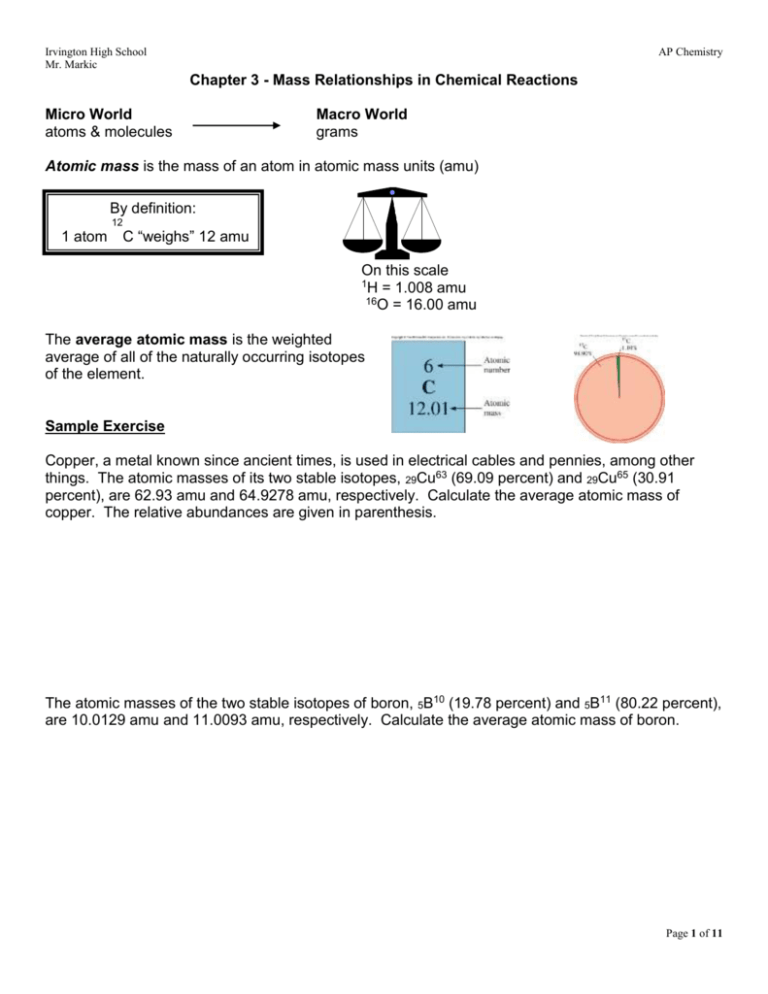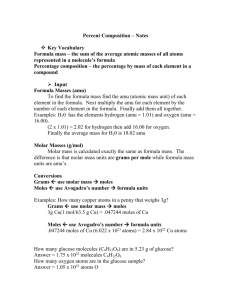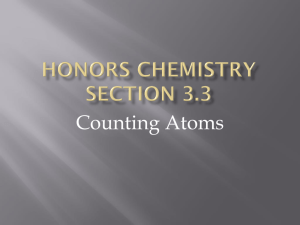File - Mr. Markic's Chemistry
advertisement

Irvington High School Mr. Markic AP Chemistry Chapter 3 - Mass Relationships in Chemical Reactions Micro World atoms & molecules Macro World grams Atomic mass is the mass of an atom in atomic mass units (amu) By definition: 1 atom 12 C “weighs” 12 amu On this scale 1H = 1.008 amu 16O = 16.00 amu The average atomic mass is the weighted average of all of the naturally occurring isotopes of the element. Sample Exercise Copper, a metal known since ancient times, is used in electrical cables and pennies, among other things. The atomic masses of its two stable isotopes, 29Cu63 (69.09 percent) and 29Cu65 (30.91 percent), are 62.93 amu and 64.9278 amu, respectively. Calculate the average atomic mass of copper. The relative abundances are given in parenthesis. The atomic masses of the two stable isotopes of boron, 5B10 (19.78 percent) and 5B11 (80.22 percent), are 10.0129 amu and 11.0093 amu, respectively. Calculate the average atomic mass of boron. Page 1 of 11 Irvington High School Mr. Markic AP Chemistry Dozen = 12 Pair = 2 The mole (mol) is the amount of a substance that contains as many elementary entities as there are atoms in exactly 12.00 grams of 12C 1 mol = NA = 6.0221367 x 1023 Avogadro’s number (NA) Molar mass is the mass of 1 mole of (eggs, shoes, marbles, atoms) in grams 1 mole 12C atoms = 6.022 x 1023 atoms = 12.00 g 1 12C atom = 12.00 amu 1 mole 12C atoms = 12.00 g 12C 1 mole lithium atoms = 6.941 g of Li For any element atomic mass (amu) = molar mass (grams) 1 amu = 1.66 x 10-24 g or 1 g = 6.022 x 1023 amu Sample Exercise Helium (He) is a valuable gas used in industry, low-temperature research, deep-sea diving tanks, and balloons. How many moles of He atoms are in 6.46 g of He? How many moles of magnesium (Mg) are there in 87.3 g of Mg? Zinc (Zn) is a silvery metal that is used in making brass (with copper) and in plating iron to prevent corrosion. How many grams of zinc are in 0.356 mole of Zn? Calculate the number of grams of lead (Pb) in 12.4 moles of lead. Page 2 of 11 Irvington High School Mr. Markic AP Chemistry Sulfur (S) is a nonmetallic element that is present in coal. When coal is burned, sulfur is converted to sulfur dioxide and eventually into sulfuring acid that gives rise to the acid rain phenomenon. How many atoms are in 16.3 g of sulfur? How many atoms are in 0.551 g of potassium (K) ? Molecular Mass Molecular mass (or molecular weight) is the sum of the atomic masses (in amu) in a molecule. 1S 2O SO2 32.07 amu + 2 x 16.00 amu 64.07 amu SO 2 M For any molecule molecular mass (amu) = molar mass (grams) 1 molecule SO2 = 64.07 amu 1 mole SO2 = 64.07 g SO2 Sample Exercise Calculate the molecular masses (in amu) of the following compounds: (a) sulfur dioxide (SO2), a gas that is responsible for acid rain (b) caffeine (C8H10N4O2), a stimulant present in tea, coffee, and cola beverages (c) What is the molecular mass of methanol (CH4O)? Methane (CH4) is the principal component of natural gas. How many moles of CH4 are present in 6.07 g of CH4? Calculate the number of moles of chloroform (CHCl3) in 198 g of chloroform. Page 3 of 11 Irvington High School Mr. Markic AP Chemistry How many hydrogen atoms are present in 25.6 g of urea (NH2)2CO, which is used as a fertilizer, in animal feed, and in the manufacture of polymers. The molar mass of urea is 60.06 g. How many H atoms are in 72.5 g of isopropanol (rubbing alcohol) C3H8O ? Formula mass is the sum of the atomic masses (in amu) in a formula unit of an ionic compound. NaCl 58.44 amu NaCl 1Na 1Cl 22.99 amu + 35.45 amu For any ionic compound formula mass (amu) = molar mass (grams) 1 formula unit NaCl = 58.44 amu 1 mole NaCl = 58.44 g NaCl Percent composition of an element in a compound = 𝒏 x molar mass of an element molar mass of a compound x 100 n is the number of moles of the element in 1 mole of the compound Sample Exercise Phosphoric Acid (H3PO4) is a colorless, syrupy liquid used in detergents, fertilizers, toothpastes, and carbonated beverages for a “tangy” flavor. Calculate the percent composition by mass of H, P, and O in the compound. Calculate the percent composition by mass of each of the elements in sulfuric acid (H2SO4) Page 4 of 11 Irvington High School Mr. Markic AP Chemistry Ascorbic acid (vitamin C) cures scurvy. It is composed of 40.92 percent carbon (C), 4.58 percent hydrogen (H), and 54.50 percent oxygen (O) by mass. Determine the empirical formula. Determine the empirical formula of a compound having the following percent composition by mass: K: 24.75 percent; Mn: 34.77 percent; O: 40.51 percent. Chalcopyrite (CuFeS2) is a principal mineral of copper. Calculate the number of kilograms of Cu in 3.71 x 103 kg of chalcopyrite. Calculate the number of grams of Al in 371 g of Al2O3. Experimental Determination of Empirical Formulas • Chemical analysis tells us the number of grams in each element present in a given amount of a compound • Then we convert the quantities in grams to number of moles of each element Then we find the empirical formula of the compound Combust 11.5 g ethanol Collect 22.0 g CO2 and 13.5 g H2O g CO2 g H2O mol CO2 mol H2O mol C mol H gC gH g of O = g of sample – (g of C + g of H) Empirical formula C0.5H1.5O0.25 Divide by smallest subscript (0.25) 6.0 g C = 0.5 mol C 1.5 g H = 1.5 mol H 4.0 g O = 0.25 mol O Empirical formula C2H6O Page 5 of 11 Irvington High School Mr. Markic AP Chemistry Sample Exercise Isopropyl alcohol is composed of C, H, and O. Combustion of 0.255g of isopropyl alcohol produces 0.561g of CO2 and 0.306g of H2O. Determine the empirical formula of isopropyl alcohol. Combustion of a 0.225g sample of caproic acid compound produces 0.512g CO 2 and 0.209g H2O. a) What is the empirical formula of caproic acid? b) What is its molecular formula (molar mass = 116 g/mol)? Sample Exercise A sample of a compound contains 30.46 percent nitrogen and 69.54 percent oxygen by mass, as determined by a mass spectrometer. In a separate experiment, the molar mass of the compound is found to be between 90 g and 95 g. Determine the molecular formula and the accurate molar mass of the compound. A sample of a compound containing boron (B) and hydrogen (H) contains 6.444 g of B and 1.803 g of H. The molar mass of the compound is about 30 g. What is its molecular formula? Page 6 of 11 Irvington High School Mr. Markic AP Chemistry A process in which one or more substances is changed into one or more new substances is a chemical reaction A chemical equation uses chemical symbols to show what happens during a chemical reaction 3 ways of representing the reaction of H2 with O2 to form H2O Reactants Products Balancing Chemical Equations 1. Write the correct formula(s) for the reactants on the left side and the correct formula(s) for the product(s) on the right side of the equation. Ethane reacts with oxygen to form carbon dioxide and water C2H6 + O2 CO2 + H2O 2. Change the numbers in front of the formulas (coefficients) to make the number of atoms of each element the same on both sides of the equation. Do not change the subscripts 2C2H6 NOT C4H12 3. Start by balancing those elements that appear in only one reactant and one product. 4. Balance those elements that appear in two or more reactants or products. 5. Check to make sure that you have the same number of each type of atom on both sides of the equation. Page 7 of 11 Irvington High School Mr. Markic AP Chemistry Sample Exercise When aluminum metal is exposed to air, a protective layer of aluminum oxide (Al 2O3) forms on its surface. This layer prevents further reaction between aluminum and oxygen, and it is the reason that aluminum beverage cans do not corrode. [In the case of iron, the rust, or iron(III) oxide, that forms is too porous to protect the iron metal underneath, so rusting continues.] Write a balanced equation for the formation of Al2O3. Practice Exercise Balance the equation representing the reaction between iron (III) oxide, Fe 2O3, and carbon monoxide (CO) to yield iron (Fe) and carbon dioxide (CO2). Amounts of Reactants and Products 1. Write balanced chemical equation 2. Convert quantities of known substances into moles 3. Use coefficients in balanced equation to calculate the number of moles of the sought quantity 4. Convert moles of sought quantity into desired units Sample Exercise The food we eat is degraded, or broken down, in our bodies to provide energy for growth and function. A general overall equation for this very complex process represents the degradation of glucose (C6H12O6) to carbon dioxide (CO2) and water (H2O): C6H12O6 + 6 O2 6 CO2 + 6 H2O If 856 g of C6H12O6 is consumed by a person over a certain period, what is the mass of CO2 produced? Methanol burns in air according to the equation: 2CH3OH + 3O2 2CO2 + 4H2O If 209 g of methanol are used up in the combustion, what mass of water is produced? Page 8 of 11 Irvington High School Mr. Markic AP Chemistry All alkali metals react with water to produce hydrogen gas and the corresponding alkali metal hydroxide. A typical reaction is that between lithium and water: 2 Li(s) + 2H2O(l) 2LiOH(aq) + H2(g) (a) How many moles of H2 will be formed by the complete reaction of 6.23 moles of Li with water? (b) How many grams of H2 will be formed by the complete reaction of 80.57 g of Li with water? The reaction between nitric oxide (NO) and oxygen to form nitrogen dioxide (NO2) is a key step in photochemical smog formation: 2 NO(g) + O2(g) 2 NO2(g). How many grams of O2 are needed to produce 2.21 g of NO2? Limiting Reagents Reactant used up first in the reaction. 2NO + O2 2NO2 NO is the limiting reagent O2 is the excess reagent Sample Exercise Urea (NH2)2CO is prepared by reacting ammonia with carbon dioxide: 2NH3(g) + CO2(g) (NH2)2CO(aq) +H2O(l) In one process, 637.2 g of NH3 are treated with 1142 g of CO2. (a) Which of the two reactants is the limiting reagent? Page 9 of 11 Irvington High School Mr. Markic AP Chemistry (b) Calculate the mass of (NH2)2CO(aq) formed (c) How much excess reagent (in grams) is left at the end of the reaction? Practice Exercise In one process, 124 g of Al are reacted with 601 g of Fe2O3: 2Al + Fe2O3 Al2O3 + 2Fe Calculate the mass of Al2O3 formed. The reaction between alcohols and halogen compounds to form ethers is important in organic chemistry, as illustrated here for the reaction between methanol (CH3OH) and methyl bromide (CH3Br) to form dimethylether (CH3OCH3), which is a useful precursor to other organic compounds and an aerosol propellant. This reaction is carried out in a dry (water-free) organic solvent, and the butyl lithium (LiC4H9) serves to remove a hydrogen ion from CH3OH. Butyl lithium will also react with any residual water in the solvent, so the reaction is typically carried out with 2.5 molar equivalents of that reagent. How many grams of CH3Br and LiC4H9 will be needed to carry out the preceding reaction with 10.0 g of CH3OH? Reaction Yield Theoretical Yield is the amount of product that would result if all the limiting reagent reacted. Actual Yield is the amount of product actually obtained from a reaction. Actual yield is almost always less than the theoretical yield (some reactants don’t always react) Actual Yield % Yield = Theoretical Yield x 100 Page 10 of 11 Irvington High School Mr. Markic AP Chemistry Sample Exercise Titanium is a strong, lightweight, corrosion-resistant metal that is used in rockets, aircraft, jet engines, and bicycle frames. It is prepared by the reaction of titanium (IV) chloride with molten magnesium between 950°C and 1150°C: TiCl4(g) + 2Mg(l) Ti(s) + 2MgCl2 In a certain industrial operation 3.54 x 107 g of TiCl4 are reacted with 1.13 x 107 g of Mg (a) Calculate the theoretical yield of Ti in grams (b) Calculate the percent yield if 7.91 x 106 g of Ti are actually obtained Industrially, vanadium metal, which is used in steel alloys, can be obtained by reacting vanadium (V) oxide with calcium at high temperatures: 5Ca + V2O5 5CaO + 2V In one process 1.54 x 103 g of V2O5 react with 1.96 x 103 g of Ca. (a) Calculate the theoretical yield of V (b) Calculate the percent yield if 803 g of V are obtained Page 11 of 11




